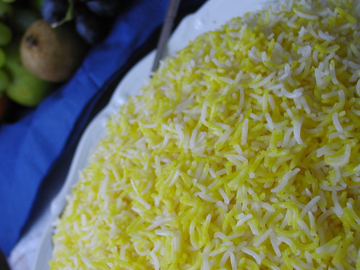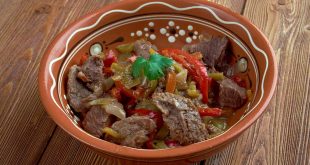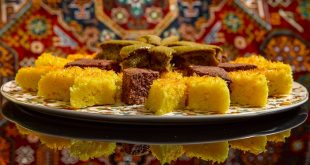
Served on special occasions, pilaf is the final savoury dish at wedding feasts, brought in with great ceremony. Known in Azerbaijani as ash (aş) or plov, rice pilaf is thought to have come to Azerbaijan from Iran and India. Azerbaijani rice should never be sticky. The basic cooking method is to parboil and then steam the rice. The pilaf is usually served on its own dish or plate, with the accompanying sauces or stews served in separate bowls. Qazmaq, a crust made at the bottom of the pan when the rice is steamed, is highly prized and is served in pieces with the rice or on a separate plate. Azerbaijani cuisine has dozens of types of pilaf, some of which will be featured on this site.
Preparation time: 10 min
Cooking time: 25 min
Serves: 3-4
Ingredients
- 800 g/2 lb basmati rice
- water
- salt
- butter
- saffron (or turmeric if saffron is not available)
- For the qazmaq-crust
- 1 egg and 1-2 tbspns yoghurt
- OR 200 g/8oz plain flour
- OR 2 medium-sized potatoes
Preparation
- Rinse the rice in cold water several times to remove excess starch.
- Put a few threads of saffron in a cup and add boiling water. Cover and leave to infuse.
- Fill a large, heavy saucepan with water and add salt. Bring to the boil. Add the rice to the boiling water. Turn the heat down slightly but cook at a rapid boil for 5 to 10 minutes. Be careful not to cook for too long or the finished rice will be sticky. To see if the rice is ready, take a couple of grains out of the pot and test them on your wet finger. The grain should be soft on the outside but still firm on the inside. When you bite into the grain or break it with a finger nail, the hard white interior should still be visible. Strain the rice through a rice colander.
- Prepare the crust or qazmaq: 3 varieties are given here. a) Mix together 1 egg, 4 tablespoons of the parboiled rice and 1-2 tablespoons of yogurt. Add some of the infused saffron water or a pinch of turmeric. OR b) For lavash qazmaq, make lavash by mixing together 1 glass (200 g/8 oz) of flour and a little water and butter. (Add 1 egg to the dough if you want an eggy flavour to the qazmaq.) Knead the dough until it is soft and roll out to a thickness of 3mm/0.2 inches. OR c) For potato qazmaq, peel and slice the potatoes widthways.
- Rinse and dry the rice pan. Return it to the heat and melt a generous knob of butter. Spread the qazmaq mixture, lavash or potato rounds over the bottom of the pan and fry for 2 to 3 minutes.
- Add the rest of the parboiled rice. Spoon it gently into the pan to avoid breaking the grains. When half the rice is in the pan, pour over some of the saffron infusion. Put the rest of the rice in the pan and pour most of the remaining saffron infusion over it. Put several knobs of butter on top. Make holes in the rice with the handle of a wooden spoon to allow the steam to escape. Place a well-fitting lid on top of the saucepan, covered underneath with a clean tea towel. The towel helps to absorb the steam. Once the rice is steaming, turn down the heat and leave to continue steaming for 30 to 45 minutes. The rice can be left to steam for longer without coming to any harm.
- Serve on a large dish. Pour the remaining saffron infusion over the top of the rice and add some more knobs of butter. The rice should be an attractive combination of yellow and white. Serve the qazmaq in pieces on top of the rice or separately.
 Oval Useful news from Azerbaijan and Caucasus
Oval Useful news from Azerbaijan and Caucasus


